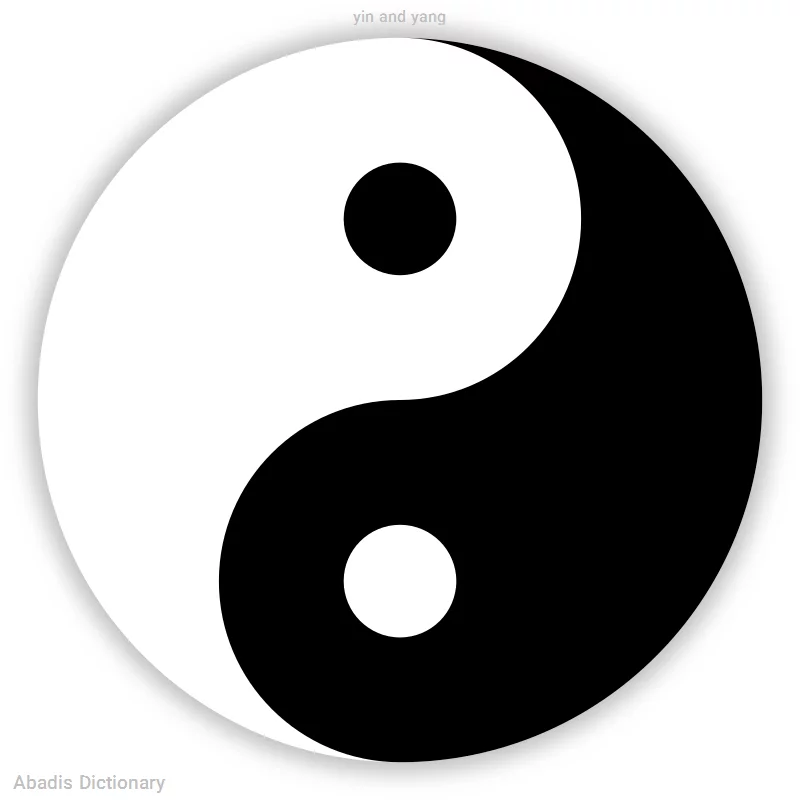yin and yang
انگلیسی به انگلیسی
پیشنهاد کاربران
Yin yang emblem : نماد یا سمبل زنانگی و مردانگی
یین و یانگ ( اسم ) : دو اصل متضاد و مکمل فلسفه چینی که گمان می رود در همه چیز به نسبت های متفاوتی وجود دارند. گاهی اوقات آنها را زنانگی و مردانگی می دانند.
یین و یانگ.
یین و یانگ دو نوع انرژی نیرو هستند که همه پدیده های طبیعی و جنبه های مربوط به آنها را در برمی گیرند.
یین و یانگ دو نوع انرژی نیرو هستند که همه پدیده های طبیعی و جنبه های مربوط به آنها را در برمی گیرند.
یین و یانگ ( Yin and Yang ) مفهومی بنیادی در فلسفه چینی است که بیان می کند تمام چیزها در جهان به صورت دو نیروی متضاد و جدانشدنی وجود دارند که همدیگر را تکمیل و تعادل می بخشند. مانند زن و مرد، تاریکی و
... [مشاهده متن کامل]

... [مشاهده متن کامل]
روشنایی، پیر و جوان. نماد آن دایره ای است که به دو قسمت سیاه ( یین ) و سفید ( یانگ ) تقسیم شده و هر قسمت نقطه ای از رنگ دیگر دارد، که نشان می دهد هر نیرو در دل خود عنصری از نیروی مقابل را دارد. ایجاد تعادل بین این نیروها برای رسیدن به هارمونی و سلامت ضروری است. این مفهوم از حداقل قرن سوم پیش از میلاد در فرهنگ و پزشکی چینی موثر بوده است.

دو اصل متضاد ولی مکمل
☯️☯️☯️☯️☯️☯️☯️☯️
In Ancient Chinese philosophy, yin and yang ( /jɪn/ and /jɑːŋ, j�ŋ/; Chinese: 陰陽 yīny�ng pronounced [ín jǎŋ], lit. "bright - black", "positive - negative" ) is a concept of dualism, describing how obviously opposite or contrary forces may actually be complementary, interconnected, and interdependent in the natural world, and how they may give rise to each other as they interrelate to one another. In Chinese cosmology, the universe creates itself out of a primary chaos of material energy, organized into the cycles of Yin and Yang and formed into objects and lives. Yin is the receptive and Yang the active principle, seen in all forms of change and difference such as the annual cycle ( winter and summer ) , the landscape ( north - facing shade and south - facing brightness ) , sexual coupling ( female and male ) , the formation of both men and women as characters and sociopolitical history ( disorder and order ) .
... [مشاهده متن کامل]
یین و یانگ ( چینی ساده شده: 阴阳، چینی سنتی: 陰陽 ) مفهومی است در نگرش و فلسفه چینیان باستان به نظام جهان و ثنویت . یین و یانگ شکل ساده شده ای از مفهوم یگانگی متضادها است. از دیدگاه چینیان باستان و تائوباوران، در همهٔ پدیده ها و اشیاء غیر ایستا در جهان هستی، دو اصل متضاد ولی مکمل وجود دارد.
یین و یانگ نشان دهنده قطب های مخالف و تضادهای جهان هستند. البته این بدان معنا نیست که یانگ خوب است و یین بد است ( در حقیقت این تحریفی نادرست است ) . بلکه یین و یانگ مانند شب و روز یا زمستان و تابستان بخشی از چرخه هستی هستند. وقتی تعادل و احساس خوبی به وجود می آید که تعادل بین یین و یانگ برقرار باشد. نقطه های متضادی که داخل شکل یین و یانگ دیده می شود به این مفهوم است که یین وقتی به حداکثر خودش برسد، و می خواهد تمام شود در درونش یانگ را دارد و وقتی هم که یانگ می خواهد به حداکثر خود برسد در درونش یین را دارد. یعنی وقتی یکی تمام می شود، دیگری در درونش رشد می کند و این چرخه ادامه پیدا می کند.
یین و یانگ به ترتیب نام اصل ها یا نیروهای مکمل مادینه و نرینهٔ جهان در فلسفهٔ ذن و تائوئیسم است که همهٔ وجوه زندگی را در بر می گیرد. یین در لغت به معنای سمت سایه گرفتهٔ تپه است و یانگ سمت آفتاب رو است. یین معمولاً مترادف زمین شمرده می شود که تاریک و سرد است و هر چیز بدی به آن نسبت داده می شود و یانگ مترادف آسمان است و روشن و گرم و خوب شمرده می شود.
هیچ چیزی کاملاً یین یا کاملاً یانگ نیست. مثلاً آب سرد در مقابل آب جوش یین است ولی در مقابل یخ یانگ میباشد.
یین و یانگ کاملاً به هم وابسته اند و هیچ کدام بدون دیگری نمی توانند وجود داشته باشند. نور بدون تاریکی معنی ندارد.
یین و یانگ می توانند خودشان تقسیم شوند به یین و یانگ: مثلاً گرم در برابر سرد ینگ است ولی گرم خود تقسیم می شود به داغ ( یانگ ) و ولرم ( یین ) ، سرد نیز خود تقسیم می شود به خنک ( یانگ ) و بسیار سرد ( یین )
■■ یانگ/یین■■
راست/چپ
اعداد فرد/اعداد زوج
ثابت/متحرک
سختی/نرمی
منحنی/زاویه دار
سنگینی سبکی
گرما/سرما
روشنایی/تاریکی
آسمان/زمین
آتش/آب
کوه/دره
تیز/کُند
بالا/پایین
جلو/عقب
روح/بدن
پُر/خالی
مردانگی/زنانگی
موفقیت/شکست
خورشید/ماه
خیر/شر
یک روح در دو بدن
بحث و جدل
غیرممکن. محال
